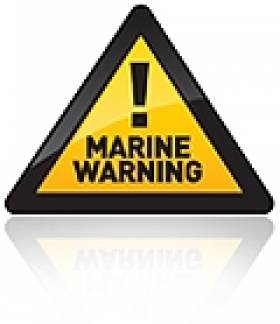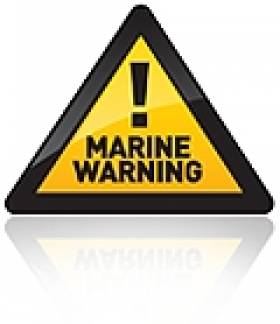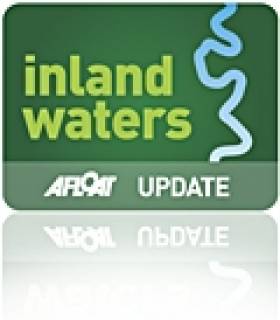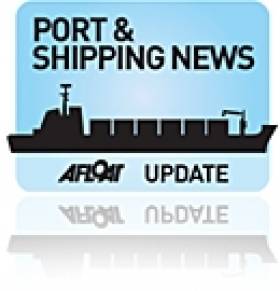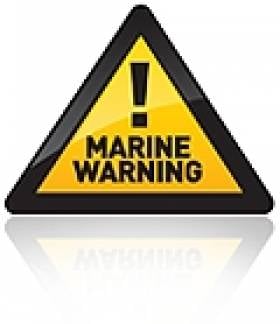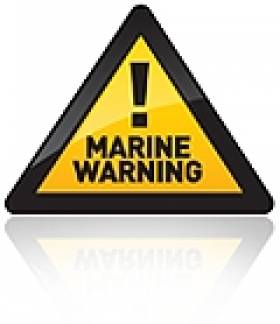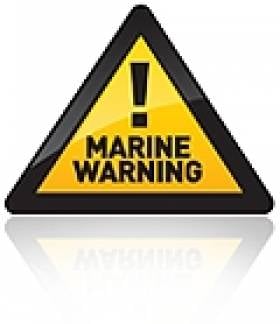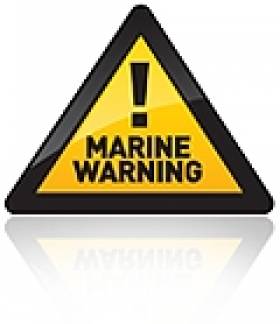Displaying items by tag: Marine Notice
#MarineNotice - The latest Marine Notice from the Department of Transport, Tourism and Sport (DTTAS) advises that umbilical installation and associated works between the Corrib Gas Field and the mainland and Broad Haven Bay in Co Mayo will commence tomorrow 8 May.
The area of activity stretches along the route of the existing Corrib pipeline, and will continue till the umbilical pull-in to Glengad and subsequent lay away of the umbilical next month, followed by further tie-in works in the Corrib field to be completed by mid-July, weather permitting.
A number of work and service vessels will be used throughout the offshore works period, with various tasks from installing the main umbilical to post-lay jetting.
In order to create a safe working environment for the near-shore diving activities and the umbilical pull-in, a Safety Zone around the bellmouth (250m radius) will be identified with red marker buoys spaced at 75m interval around the circumference of the zone.
All vessels in the vicinity are requested to keep clear of the works as these works progress along the pipeline route and to comply with requests from support vessels and safety boats.
Furthermore, all vessels are requested to monitor and comply with the Radio Navigational Warnings that will be broadcast for the duration of the works. All vessels involved in the operations will be listening on VHF Channel 16 throughout the project.
Full details of co-ordinates of the work area and the work vessels involved are included in Marine Notice No 20 of 2013, a PDF of which is available to read or download HERE.
#MarineNotice - The Department of Transport, Tourism and Sport (DTTAS) has issued a Marine Notice advising that a hydrographic and geophysical survey operation is taking place off the south coast till 4 June.
The RV Celtic Voyager (Call sign EIQN) - which performed a similar task off the Clare coast last month - is carrying out the survey operations in an area along the Cork coast marked out in Marine Notice No 18 of 2013, a PDF of which is available to read or download HERE.
The vessel will be towing a magnetometer sensor with a single cable of up to 100m in length. As usual, the vessel will display appropriate lights and markers, and will be listening on VHP Channel 16 throughout the project.
MARINE NOTICE No. 25 of 2013 ERNE NAVIGATION UPPER LOUGH ERNE TEMPORARY CLOSURE OF PUBLIC JETTY AT CROM
Waterways Ireland wishes to advise masters and owners that the mooring jetty at the above location has been temporarily closed to the public to facilitate emergency repair works.
Waterways Ireland apologises for any inconvenience caused during these works.
Charles Lawn
Lt Cdr (rtd)
Inspector of Navigation
19 Apr 2013
Tel: 00 353 (0)90 6494232 Fax :00 353 6494147
#MarineNotice - Marine Notice No 17 of 2013 from the Department of Transport, Tourism and Sport (DTTAS) advises on two minor amendments to ship security plans and on-board retention of security records, in accordance with Regulation (EC) No 725/2004 and the International Ship and Port Facility Security Code (ISPS Code).
Firstly, and with immediate effect, there is no requirement to inform the Marine Survey Office of minor amendments to ship security plans.
Such minor amendments include amendments to contact details of shipping company personnel, and may also include other minor adjustments to the text. Minor amendments are such that the structure, scope and implementing measures contained in the plan are not amended.
If in any doubt the company security officer should contact the Marine Survey Office for further guidance. All amendments should be recorded appropriately.
Secondly, the DTTAS advises that, with immediate effect, the minimum period for the retention of security records on board (relating to drills, exercises, declarations of security, etc) is reduced to three years.
#MarineNotice - Marine Notice No 15 of 2013 from the Department of Transport, Tourism and Sport (DTTAS) advises mariners that a hydrographic and geophysical survey operation is being undertaken by INFOMAR for the Sustainable Energy Authority of Ireland till 25 April.
The RV Celtic Voyager (Call sign EIQN) is carrying out the survey operations within an area bounded by co-ordinates included in the notice, available as a PDF to read or download HERE.
The vessel is towing a magnetometer sensor with a single cable of up to 100m in length. It is also displaying appropriate lights and markers, and will listen in on VHF Channel 16 throughout the project.
Meanwhile, Marine Notice No 16 of 2013 advises that Shell E&P Ireland is deploying a Waverider buoy off northwest Co Mayo to help predict sea conditions for the laying of an offshore umbilical to the Corrib Gas Field later this year.
The buoy is yellow in colour and will flash yellow five times every 20 seconds. The notice includes an image of what the buoy looks like in the water, as well as the co-ordinates of its placement.
All vessels are requested to give the wave buoy a wide berth.
Marine Notice: 3D Seismic Surveys In Celtic Sea
#MarineNotice - Further to the recent notice of a 2D seismic survey in the Atlantic waters of the Irish continental shelf, Marine Notice No 14 of 2013 advises mariners of two full 3D seismic surveys in the Celtic Sea off the south coast.
CGG will be conducting the surveys on behalf of Fastnet Oil & Gas as part of its option on the Deep Kinsale Prospect, as previously reported on Afloat.ie.
The works are expected to commence in later this month and are expected to last around 50 days, subject to weather, beginning with the Deep Kinsale survey followed by the Mizen survey.
The seismic vessel SR/V Vantage (Call sign LMHY3) is scheduled to carry out the work. The vessel will be towing 10 cables, each 6km long with 100m separation for a total width of 900m, at a depth of seven metres. The vessel will also tow two source arrays, each made of three subarrays, each with a width of 16m and at a depth of six metres.
The seismic vessel will be accompanied by support vessel M/V Oms Resolution (Call sign HP5135) and chase vessel M/V Stormbas II (Call sign V4EM2).
In addition, as part of the Deep Kinsale survey, a second 3D seismic vessel M/V Artemis Angler (Call sign LAGU7) will assist in an undershoot of the Kinsale Alpha and Bravo platforms. The two 3D seismic vessels will sail in parallel at the same speed, one on each side of the platforms using streamers. The undershoot aspect of the acquisition is expected to last two to three days.
The seismic vessels will be restricted in their ability to manoeuvre whilst carrying out the surveys and all other vessels are requested to give these operations a wide berth. All project vessels will be listening on VHF Channel 16 throughout the project.
All vessels, particularly those engaged in fishing, are requested to give the SR/V Vantage, the M/V Artemis Angler and their towed equipment a wide berth and keep a sharp lookout in the relevant areas.
Full details of co-ordinates of the survey areas are included in Marine Notice No 14 of 2013, a PDF of which is available to read or download HERE.
Marine Notice: New Seismic Survey Of Continental Shelf
#MarineNotice - The latest Marine Notice from the Department of Transport, Tourism and Sport advises mariners that ENI Ireland BV is scheduled to conduct a 2D seismic survey in the Atlantic waters of the Irish Designated Continental Shelf.
The planned start of the survey is mid-April 2013 and, weather permitting, will continue until mid-October 2013.
The proposed survey consists of 18,000km of a full-fold 2D seismic survey in offshore waters beyond the 12-nautical-mile limit, and extends into international (high seas) waters.
The seismic acquisition will be carried out by the seismic vessel M/V BGP Explorer (Call sign HP4919), which will be accompanied at all times by guard vessel M/V Alk Explorer (Call sign HO2639). In addition, M/V De Vrouw Marie (Call sign HP9974) will act as a supply vessel for the re-supply of materials.
M/V BGP Explorer will tow a single solid 10km streamer. The vessel will travel at 4–5 knots and the streamer will be located approximately 10 metres below the surface. All vessels will be listening on VHF Channel 16 throughout the project.
The notice requests all vessels, particularly those engaged in fishing, to give the M/V BGP Explorer, the M/V Alk Explorer and the supply vessel a wide berth, and keep a sharp lookout in the relevant areas.
Details of co-ordinates for the seismic survey are included in Marine Notice No 13 of 2013, a PDF of which is available to read or download HERE.
Notice of this latest seismic survey comes after the news that the European Commission has sought an explanation from the Government over why it has not conducted environmental impact assessments for such operations in Irish waters, which are a designated whale and dolphin sanctuary.
Meanwhile, another recent Marine Notice advises passenger ship operators of the requirements for vessels engaged in the tendering of passengers between ship and shore.
Full details on the relevant provisions of the Merchant Shipping Acts are included in Marine Notice No 12 of 2013 available HERE.
Marine Notice: Deepwater Well Drilling Off South-West Coast
#MarineNotice - Marine Notice No 11 of 2013 from the DTTAS advises all seafarers that a deepwater exploration well will be drilled off the south-west coast of Ireland from the end of March 2013.
ExxonMobil Exploration and Production Ireland (Offshore) Limited is scheduled to drill the deepwater exploration well in Frontier Exploration Licence 3/04 ('Dunquin'). The proposed location is Latitude 51°19'54"N, Longitude 012°27'30"W (Geodetic datum: WGS84).
The rig will be on location from approximately late March 2013, and the drilling operations will last between 90 and 120 days.
The operation will be undertaken by Ocean Rig's semi-submersible drilling rig Eirik Raude (Call sign: C6QE7) and will be supported by supply vessels operating out of the Port of Cork. A 500-metre exclusion zone around the rig must be observed at all times. The work vessels will be listening on VHF Channel 16 throughout the project.
All other vessels, particularly those engaged in fishing, are requested to give the Eirik Raude a wide berth and keep a sharp lookout in the relevant area.
Marine Notice: Clare Coast Hydrographic Survey
#MarineNotice - The latest Marine Notice from the Department of Transport, Tourism and Sport advises of a hydrographic and geophysical survey operation being presently undertaken off the Clare coast till Tuesday 19 March.
The RV Celtic Voyager (Call sign EIQN) is carrying out these survey operations for INFOMAR on behalf of the Sustainable Energy Authority of Ireland (SEAI).
The vessel will be towing a magnetometer sensor with a single cable of up to 100m in length. The Celtic Voyager will be listening on VHF Channel 16 throughout the project and will display appropriate lights and markers.
Details of co-ordinates for the survey area are included in Marine Notice No 10 of 2013, a PDF of which is available to read or download HERE.
Marine Notice: Offshore Trenching Works At Corrib Gas Field
#MarineNotice - Marine Notice No 9 of 2013 advise of preparatory works for the installation of an offshore umbilical at the Corrib Gas Field development off Co Mayo.
Works are set to commence in early March along the route of the existing Corrib offshore gas pipeline with a route survey and pre-cut trenching by the Normand Ranger (Call sign LAMT).
A trench will be constructed from the subsea facilities and well in the Corrib Gas Field to approximately 16km offshore using a subsea plough pulled by the trenching support vessel.
This plough could trail as far as 1,700m behind the support vessel, and so all vessels in the vicinity are requested to keep a wide berth clear of the works. All vessel involved in the operations will be listening on VHF Channel 16 throughout the project.
Full details including relevant co-ordinates are included in the Marine Notice, a PDF of which is available to read or download HERE.



























